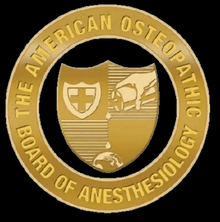American Osteopathic Board of Anesthesiology
The American Osteopathic Board of Anesthesiology (AOBA) is an organization that provides board certification to qualified Doctors of Osteopathic Medicine (D.O.) who specialize in the administration of anesthetic agents and perioperative medicine (anesthesiologists). The board is one 16 medical specialty certifying boards of the American Osteopathic Association Bureau of Osteopathic Specialists approved by the American Osteopathic Association (AOA),[4][5] and was established in 1956. As of October 2019, 720 osteopathic anesthesiologists held active certification with the AOBA. Currently 85 Diplomates have subspecialty certification in Pain Management, 13 in Critical Care Medicine, and 20 in Pediatric Anesthesiology. [6]
 | |
| Abbreviation | AOBA |
|---|---|
| Predecessor | AOBS (1940–1955) |
| Formation | 1956[1] |
| Type | Professional |
| Headquarters | Chicago, IL[2] |
| Coordinates | 41.89335°N 87.623616°W |
Chair | Brett Groff, DO, FAOCA [3] |
Vice-Chair | Jonathan Klein, DO, FAOCA |
Secretary | Nicholas Ford, DO, FAOCA |
Immediate Past Chair | Allan Escher, DO, FAOCA |
Key people | Vivian Ross, MAFM, Certification Director |
| Website | certification |
Since its inception, approximately 1,200 physicians have achieved primary certification in anesthesiology.[7]
The AOBA is one of two certifying boards for anesthesiologists in the United States. The other certifying authority is the American Board of Anesthesiology, a member board of the American Board of Medical Specialties.
History
From June 26, 1940 until the creation of the AOBA, the American Osteopathic Board of Surgery (AOBS) certified osteopathic anesthesiologists. In 1949, a group of 36 osteopathic anesthesiologists met in Detroit, Michigan to join together and form the American Society of Osteopathic Anesthesiologists (ASOA). The original six members of the ASOA Board of Governors were each certified in anesthesiology by the AOBS. In 1950, Crawford Esterline, DO invited all osteopathic anesthesiologists to join the ASOA, the "foundation for a separate college and certifying board in the future."[8]
In 1952, the American Osteopathic College of Anesthesiologists (AOCA) received recognition by the American Osteopathic Association as a separate college; the records and assets of the ASOA were transferred to the fledgling college. During the 1955 AOCA meeting in Washington, DC on motion by B.H. Traven, DO, and unanimous vote by the members present, the Board of Governors moved to "request a separate Board of Certification in Anesthesiology."[8]
Board certification
Initial certification is available to osteopathic anesthesiologists who have successfully completed an AOA-approved residency in anesthesiology, two years of practice, and successful completion of written exams, oral exams, and clinical exams.[9]
Board certified osteopathic anesthesiologists must participate in Osteopathic Continuous Certification every ten years to avoid expiration of their board certified status.[10]
Effective June 1, 2019, all AOA specialty certifying boards implemented an updated continuous certification process for osteopathic physicians, called “(OCC)”, and are required to publish the requirements for OCC in their basic documents. The following components comprise the updated OCC process:[11]
- Component 1: Licensure. AOA board-certified physicians must hold a valid, active license to practice medicine in one of the 50 states or Canada.
- Component 2: Lifelong Learning/Continuing Medical Education. A minimum of 75 CME credits in the specialty area of certification during each 3-year cycle. Of these 75 specialty CME credits, 18 of these CME hours must be AOA Category 1-A CME. The remaining 57 hours will have broad acceptance of specialty CME. Physicians holding one or more subspecialty certifications must earn a minimum of 15 specialty credits (25% of the requirements for primary specialty certification) in each subspecialty area during each CME cycle.
- Component 3: Cognitive Assessment: AOBA board-certified physicians must complete the online cognitive assessment every 3 years to maintain compliance with OCC.
- Component 4: Practice Performance Assessment and Improvement. Attestation of participation in quality improvement activities. View the Attestation Form by logging in with your AOA credentials to the Physician Portal on the AOA website. Completion of Practice Performance Assessment (PPA). To view more information on how to submit a PPA, visit the AOBA website.
Osteopathic anesthesiologists may also receive Subspecialty Certification in Critical Care Medicine, Pain Management, and Pediatric Anesthesiology. The Subspecialty Certification must be maintained through the process of Osteopathic Continuous Certification every 10 years. [12]
Effective July 1, 2020, allopathic (MD) physicians may apply for certification by the AOBA.[13]
See also
- American Board of Anesthesiology
- American Osteopathic Association Bureau of Osteopathic Specialists
- American Board of Medical Specialties
- Accreditation Council for Graduate Medical Education
References
- "Frequently Asked Questions". American Osteopathic Association. 2019. Retrieved 29 July 2019.
- "Contact Us". American Osteopathic Board of Anesthesiology. 2019. Retrieved 29 July 2019.
- "Board Members". American Osteopathic Board of Anesthesiology. 2019. Retrieved 29 July 2019.
- "American Osteopathic Board of Anesthesiology". Health Workforce Information Center. 2011. Archived from the original on 15 April 2013. Retrieved 14 September 2012.
- "AOA Specialty Certifying Boards". American Osteopathic Association. Retrieved 29 July 2019.
- work=|publisher=American Osteopathic Board of Anesthesiology |accessdate=07 October 2019
- work=|publisher=American Osteopathic Board of Anesthesiology |accessdate=08 October 2019
- Traven, Boris. "History of the American Osteopathic College of Anesthesiologists" (PDF). www.aocaonline.org/. American Osteopathic College of Anesthesiologists. Retrieved 9 August 2017.
- "Certification". American Osteopathic Board of Anesthesiology. 2019. Retrieved 29 July 2019.
- "OCC Overview". American Osteopathic Board of Anesthesiology. 2019. Retrieved 29 July 2019.
- Handbook of the Bureau of Osteopathic Specialists (BOS), Policies and Procedures of the BOS and AOA Specialty Certifying Boards Revised July 2019 |accessdate=10 July 2019
- work=|publisher=American Osteopathic Board of Anesthesiology |accessdate=07 October 2019
- work=|publisher=American Osteopathic Board of Anesthesiology |accessdate=08 October 2019